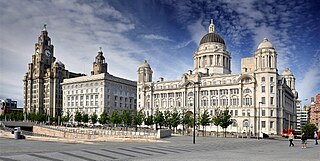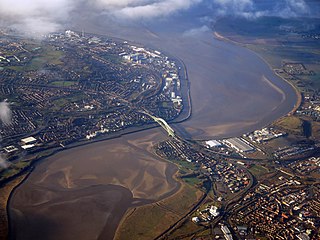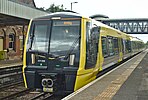
Cheshire is a ceremonial county in North West England. It is bordered by Merseyside to the north-west, Greater Manchester to the north-east, Derbyshire to the east, Staffordshire to the south-east, and Shropshire to the south; to the west it is bordered by the Welsh counties of Flintshire and Wrexham, and has a short coastline on the Dee Estuary. Warrington is the largest settlement, and the city of Chester is the county town.

Liverpool is a city and metropolitan borough in Merseyside, northwest England. It had a population of 496,770 in 2022. The city is located on the eastern side of the Mersey Estuary, adjacent to the Irish Sea, and is approximately 178 miles (286 km) from London. Liverpool is the fifth largest city in the United Kingdom, the largest settlement in Merseyside and part of the Liverpool City Region, a combined authority with a population of over 1.5 million.

North West England is one of nine official regions of England and consists of the ceremonial counties of Cheshire, Cumbria, Greater Manchester, Lancashire and Merseyside. The North West had a population of 7,417,397 in 2021. It is the third-most-populated region in the United Kingdom, after the South East and Greater London. The largest settlements are Manchester and Liverpool.

Merseyside is a ceremonial and metropolitan county in North West England. It borders Lancashire to the north, Greater Manchester to the east, Cheshire to the south, the Welsh county of Flintshire across the Dee Estuary to the southwest, and the Irish Sea to the west. The largest settlement is the city of Liverpool.

The River Mersey is a major river in North West England. Its name derives from Old English and means "boundary river", possibly referring to its having been a border between the ancient kingdoms of Mercia and Northumbria. For centuries it has formed part of the boundary between the historic counties of Lancashire and Cheshire.

The Metropolitan Borough of Sefton is a metropolitan borough of Merseyside, England. It was formed on 1 April 1974, by the amalgamation of the county boroughs of Bootle and Southport, the municipal borough of Crosby, the urban districts of Formby and Litherland, and part of West Lancashire Rural District. It consists of a coastal strip of land on the Irish Sea which extends from Southport in the north to Bootle in the south, and an inland part to Maghull in the south-east, bounded by the city of Liverpool to the south, the Metropolitan Borough of Knowsley to the south-east, and West Lancashire to the east.

Merseyrail is a commuter rail network which serves Merseyside and adjacent areas of Cheshire and Lancashire. Merseyrail serves 69 stations, 67 of which it manages, across two lines – the Northern Line and the Wirral Line. The network uses 750 V DC third rail electrified lines having 75.0 miles (120.7 km) of routes, of which 6.5 miles (10.5 km) are underground. Since January 2023, Merseyrail commenced replacing its train fleet, withdrawing the Class 507 and 508 trains and introducing 53 new Class 777 trains. The network carried 25.5 million passengers in the 2022/2023 statistical period.

Halton is a unitary authority district with borough status in Cheshire, North West England. It was created in 1974 as a district of the non-metropolitan county of Cheshire, and became a unitary authority area on 1 April 1998 under Halton Borough Council. Since 2014, it has been a member of the Liverpool City Region Combined Authority. The borough consists of the towns of Runcorn and Widnes and the civil parishes of Daresbury, Hale, Halebank, Moore, Preston Brook, and Sandymoor. The district borders Merseyside, the Borough of Warrington and Cheshire West and Chester.
Merseytravel is the passenger transport executive, responsible for the coordination of public transport in the Liverpool City Region in North West England. Merseytravel was established on 1 December 1969 as the Merseyside Passenger Transport Executive. From 1 April 2014, with the creation of the Liverpool City Region, Merseytravel expanded its area of operation from the metropolitan county of Merseyside to also include the Borough of Halton.

Merseyside Fire and Rescue Service is the statutory fire and rescue service covering the county of Merseyside in north-west England and is the statutory Fire and Rescue Authority responsible for all 999 fire brigade calls in Sefton, Knowsley, St. Helens, Liverpool and Wirral.

Halton Curve is a short bi-directional railway line which links the Chester–Warrington line to the Weaver Junction–Liverpool line within the borough of Halton, Cheshire. The route, which is 1 mile 54 chains (2.7 km) long, is between Frodsham Junction and Halton Junction. After having no regular services for more than four decades, the line was upgraded and reopened in 2019 by Network Rail, enabling hourly passenger trains between Chester and Liverpool.

Halton Borough Council is the local authority for the Borough of Halton, incorporating the towns of Runcorn and Widnes and the parishes of Daresbury, Hale, Moore and Preston Brook. It is a constituent council of Liverpool City Region Combined Authority.
Liverpool in North West England, is a major British city with significant road, rail, and ferry networks, in addition to an international airport and a well-known dock system. As with most other major UK cities, Liverpool's transport infrastructure is centred on its road and rail networks. Public transport services within the city are controlled and run by Merseytravel.

The economy of Liverpool encompasses a wide range of economic activity that occurs within and surrounding the city of Liverpool, England.

The Liverpool City Region Combined Authority (LCRCA), officially the Halton, Knowsley, Liverpool, St Helens, Sefton and Wirral Combined Authority, is the combined authority of the Liverpool City Region in England. Its area includes the City of Liverpool local authority area, the Metropolitan Boroughs of Knowsley, St Helens, Sefton, and Wirral, and the Borough of Halton. It was established on 1 April 2014 by statutory instrument under the provisions of the Local Democracy, Economic Development and Construction Act 2009. Composition of the combined authority is made up of the leaders of the six principal membership authorities, plus several non-voting members with various vested interests in the activities of the combined authority.

The inaugural Liverpool City Region mayoral election was held on 4 May 2017 to elect the Liverpool City Region Combined Authority and won by Steve Rotheram. Subsequent elections were planned for May 2020 but were postponed until May 2021 due to the covid pandemic with subsequent elections due every four years. The metro mayor will have control over the whole Liverpool City Region combined authority area which consists of the following local authorities:

The Mayor of the Liverpool City Region, is a combined authority mayor, who chairs the Liverpool City Region Combined Authority. The first, and current, officeholder is Steve Rotheram, who was elected to the post in May 2017.

The second Liverpool City Region mayoral election was held in May 2021 to elect the mayor of the Liverpool City Region, alongside other local elections across England and Wales, to elect councillors, the mayor of Liverpool, and police and crime commissioners across the city region. The election was originally due to take place in May 2020, but was postponed due to the COVID-19 pandemic.




































